How to enable Microsoft Teams notification channel in Operations Manager
This article describes how to configure a notification channel that will send alert notifications to subscribers by using Microsoft Teams.
Earlier, System Center - Operations Manager supported integration with Skype for Business that allowed the users to receive alerts from Operations Manager. All Skype for Business customers were encouraged to start using Microsoft Teams as their communications and collaboration service as Skype for Business was retired on July 31, 2021.
In line with the lifecycle, we now support Operations Manager alerts on Microsoft Teams (Teams). Integration of Teams with Operations Manager enhances productivity, as you can receive the Operations Manager alerts to Teams directly where you collaborate the most.
With System Center 2022, Microsoft Teams has been added to the existing basic Notification channels of Operations Manager. You can specify conditions for the channel to allow only certain types of alerts.
To configure alert notifications for Operations Manager, you must enable a notification channel. For detailed information about notification channels, see Subscribing to alert notifications.
Note
Integration of Operations Manager with Teams is supported for customers who use GCC, GCC High, and DoD Clouds.
Before you begin, ensure you've the following:
Teams tenant information.
Run As account. Delegated API type is used in Teams integration and the Run As account credentials will be used to authenticate. Run As account should be
- A valid Azure Active Directory (Azure AD) account (sample: user@domain)
- Licensed to use Microsoft Teams
- A member of target Microsoft Teams channel
- Not enabled for multifactor authentication (MFA)
For more information, see How to create and configure the Notification action account.
Link to the Teams channel created. For more information about Teams channels, see Overview of Teams and channels in Microsoft Teams.
Details of the newly created application in Azure. Instructions to register an application available at Register an application with the Microsoft identity platform.
For the newly created App, ensure the Graph API permission is given as ChannelMessage.Send and Grant admin consent for Contoso is selected.

On the Azure Active Directory admin center > Advanced settings, ensure Allow public client flows is set to Yes.
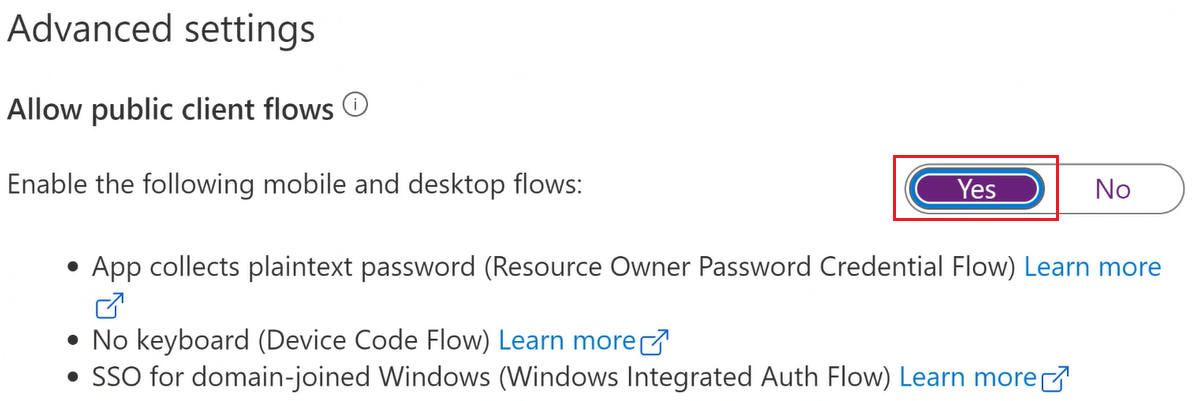
Operations Manager notification channel - key descriptions
For detailed information about Channel, Subscriber and Subscription, see Subscribing to Alert Notifications.
| Parameters | Microsoft Teams |
|---|---|
| Notifications Channel | Provide Azure endpoints, Azure / Microsoft 365 authentication details such as application ID and tenant ID, format of notifications that will be sent to Microsoft Teams. |
| Notifications Subscriber | Provide notification schedule and Microsoft Teams channel details to which notifications will be sent. |
| Notifications Subscription | Set criteria & scope on alerts that will be sent as notifications to Microsoft Teams. Subscription defines the criteria for sending a notification, the channel to be used, and the subscribers to receive the notification. |
Integrate Operations Manager with Microsoft Teams
To integrate Operations Manager with Teams, configure a Teams channel, add a subscriber, and a subscription.
Create and enable the Microsoft Teams notification channel
Follow these steps:
Sign in to the computer where the Operations Manager Console is installed.
On the console, under Notifications, right-click Channels, select New channel > Microsoft Teams…. Microsoft Teams Notification Channel wizard opens.
Under Description, enter the Channel name, Description (optional) and select Next.
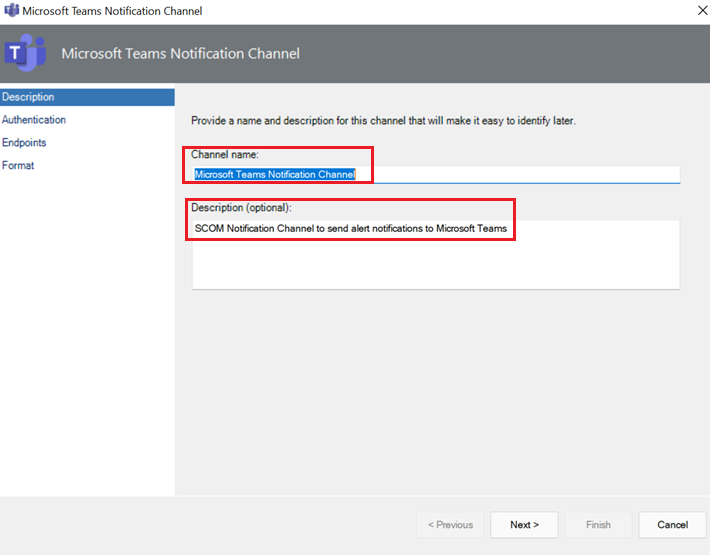
Under Authentication, enter Tenant Id, Client Id of your Azure Active Directory (Azure AD) App, and select Next.

Under Endpoints, Authorization URL and Graph API URL for your Cloud are set by default. Select Next. (See National cloud deployments for correct endpoints, if you aren't a public cloud user).

Under Format, in the Teams Message box, you've a default alert format using Adaptive Cards to deliver rich alerts. Select Finish.
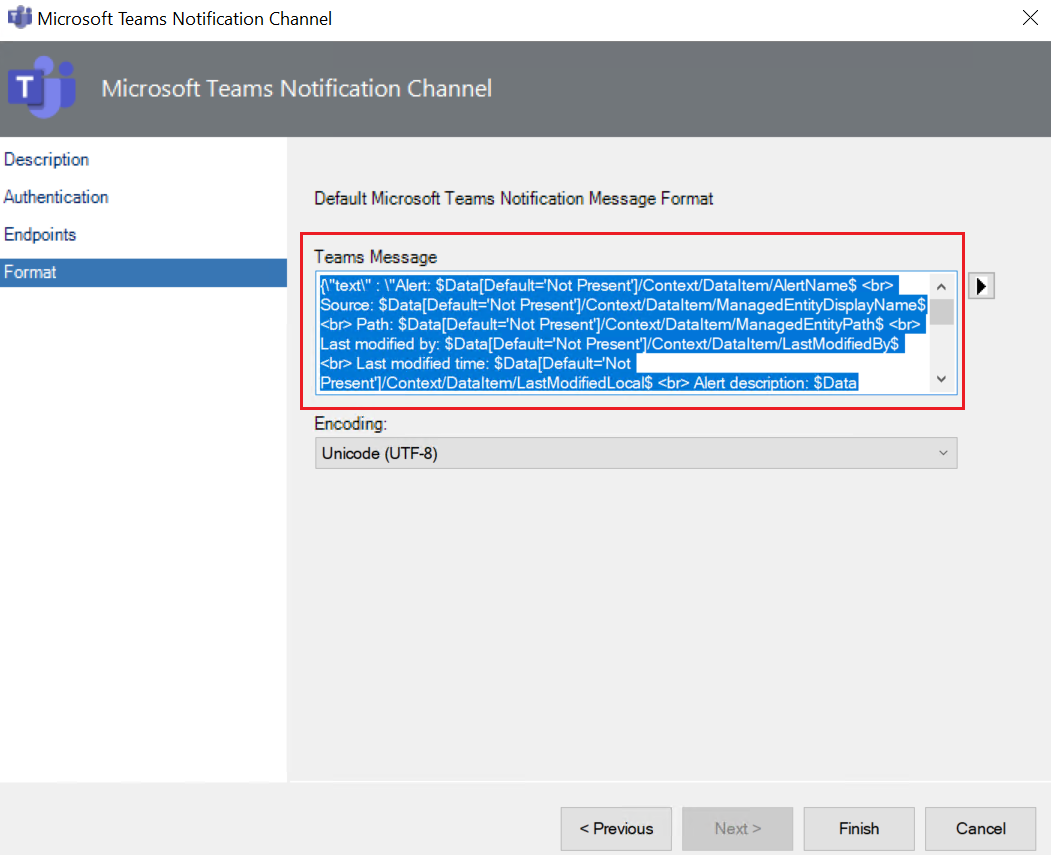
See Adaptive Cards Overview to customize the Teams message as required. Also, see Adaptive Cards to know additional information about Adaptive cards.
The following table highlights the variables to use for various properties of the alert or links to the HTML content.
| Alert property of the link | Variable |
|---|---|
| Alert Source | $Data[Default='Not Present']/Context/DataItem/ManagedEntityPath$$Data[Default='Not Present']/Context/DataItem/ManagedEntityDisplayName$ |
| Alert Name | $Data[Default='Not Present']/Context/DataItem/AlertName$ |
| Alert Description | $Data[Default='Not Present']/Context/DataItem/AlertDescription$ |
| Alert Severity | $Data[Default='Not Present']/Context/DataItem/Severity$ |
| Alert Priority | $Data[Default='Not Present']/Context/DataItem/Priority$ |
| Alert Category | $Data[Default='Not Present']/Context/DataItem/Category$ |
| Alert Owner | $Data[Default='Not Present']/Context/DataItem/AlertOwner$ |
| Alert Resolved By | $Data[Default='Not Present']/Context/DataItem/ResolvedBy$ |
| Alert Raised Time | $Data[Default='Not Present']/Context/DataItem/TimeRaisedLocal$ |
| Alert Last Modified Time | $Data[Default='Not Present']/Context/DataItem/LastModifiedLocal$ |
| Alert Last Modified By | $Data[Default='Not Present']/Context/DataItem/LastModifiedBy$ |
| Custom FieldN (N varies from 1 to 10) | $Data[Default='Not Present']/Context/DataItem/CustomN$ |
| WebConsole Alert Link | $Target/Property[Type="Notification!Microsoft.SystemCenter.AlertNotificationSubscriptionServer"]/WebConsoleUrl$/#/monitoring/drilldown/alert/$UrlEncodeData/Context/DataItem/AlertId$ |
| WebConsole Alert Source Link | $Target/Property[Type="Notification!Microsoft.SystemCenter.AlertNotificationSubscriptionServer"]/WebConsoleUrl$/#/monitoring/drilldown/object/$UrlEncodeData/Context/DataItem/ManagedEntity$ |
Add a subscriber to the notification channel
Follow these steps:
Sign in to the computer where the Operations Manager Console is installed. On the console, under Notifications, right-click Subscribers, and select Microsoft Teams. Notification Subscriber Wizard opens.
Under Description, enter Subscriber Name and select Next.

Under Schedule, select any of the following options based on your requirement and select Next.
- Always send notifications - Allows you to send the notifications all the time.
- Notify only during the specified times - Allows you to send the notification only on specified times.
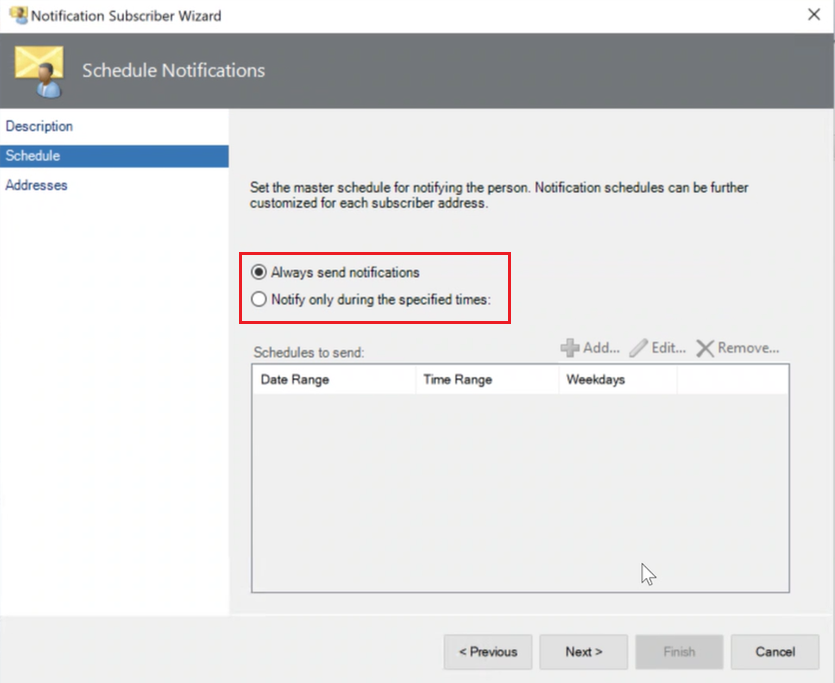
If you select Notify only during the specified times option, Specify Schedule page opens. Select the Date range, Weekly recurrence, On the selected days of the week, and Time zone based on your requirement.

Under Addresses, select Add. Subscribers Address wizard opens.
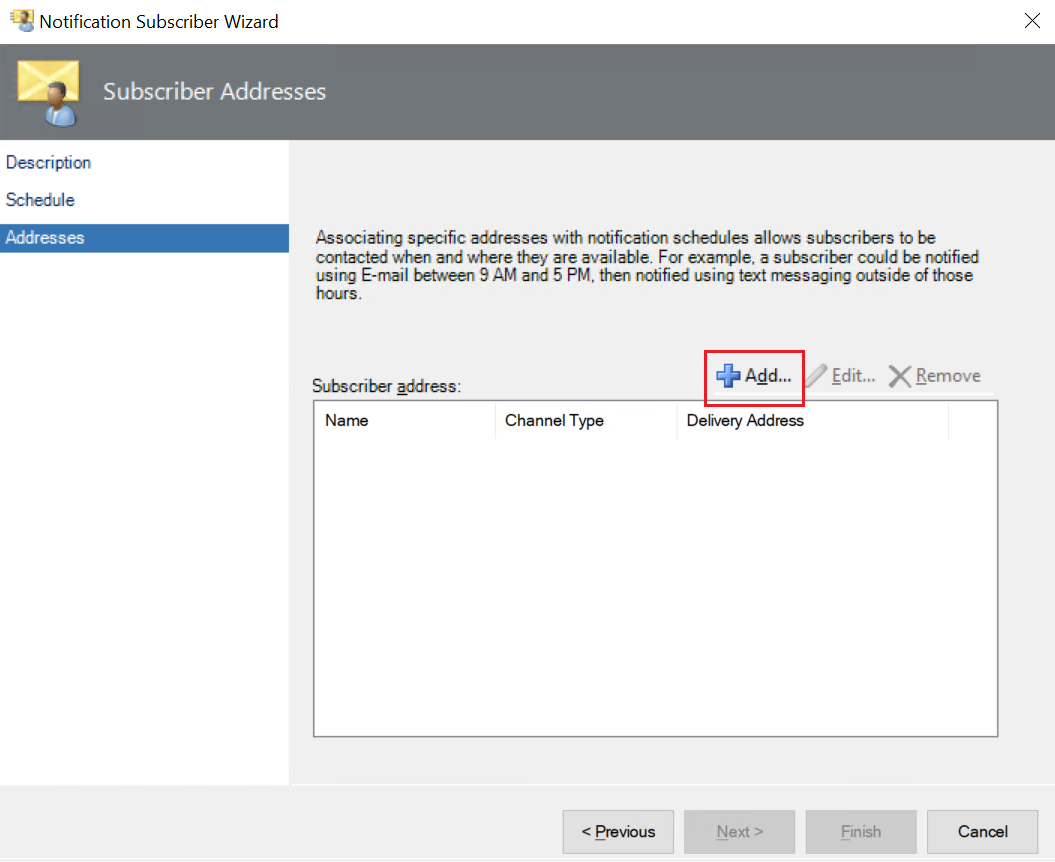
Under General, enter Address name to identify the subscriber.
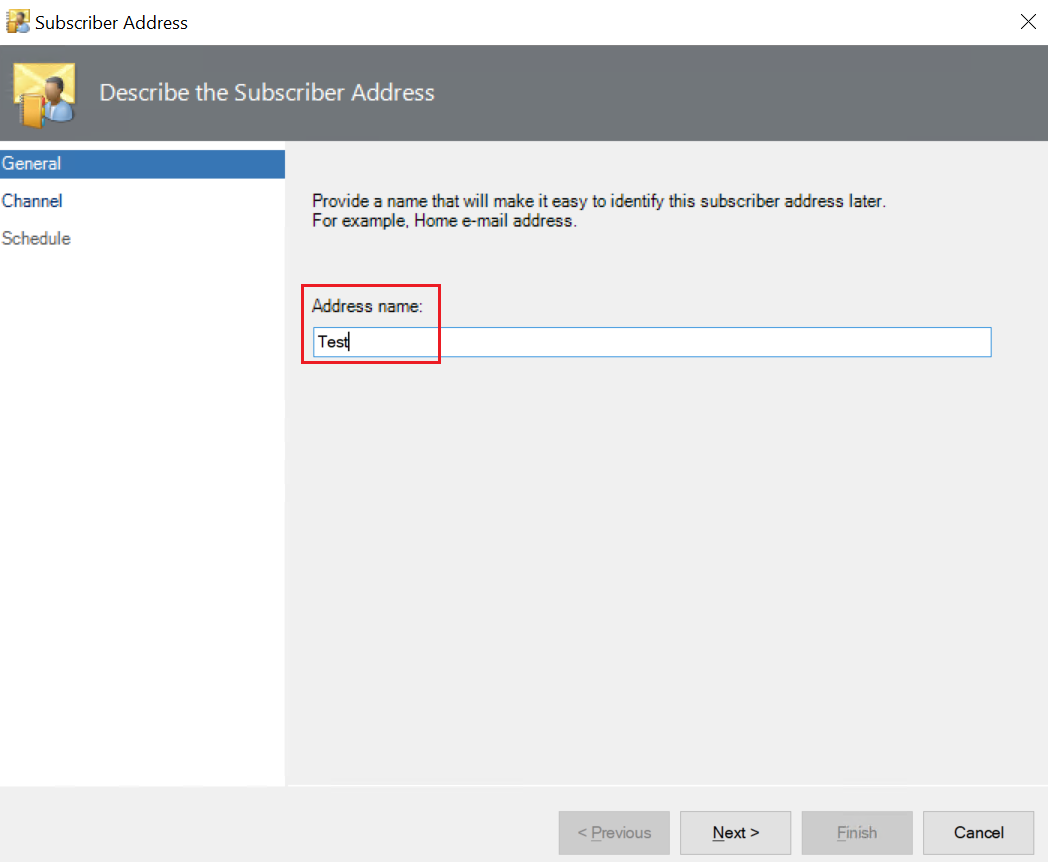
Under Channel, enter Channel Type as Microsoft Teams.
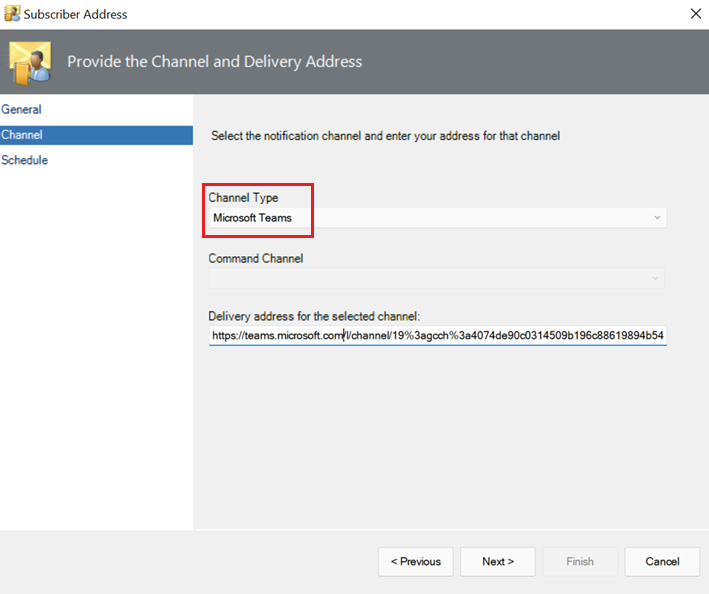
In the Microsoft Teams, right-click the channel where you want to send the notifications, select Get link to channel and copy the URL and enter the URL in the Delivery address for the selected channel: field.

Under Schedule, specify Date range, Weekly recurrence, On the selected days of the week, Time zone as required, and select Finish.
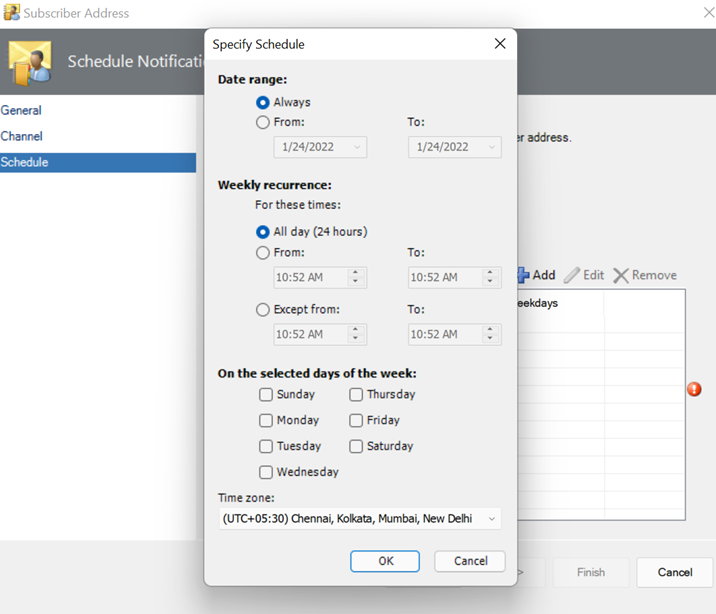
Configure a notification subscription
Follow these steps:
Sign in to the computer where the Operations Manager Console is installed.
On the console, under Notifications, right-click Subscriptions, select New subscription.... Create Notification Subscription wizard opens.

Under Description, enter Subscription name and select Next.
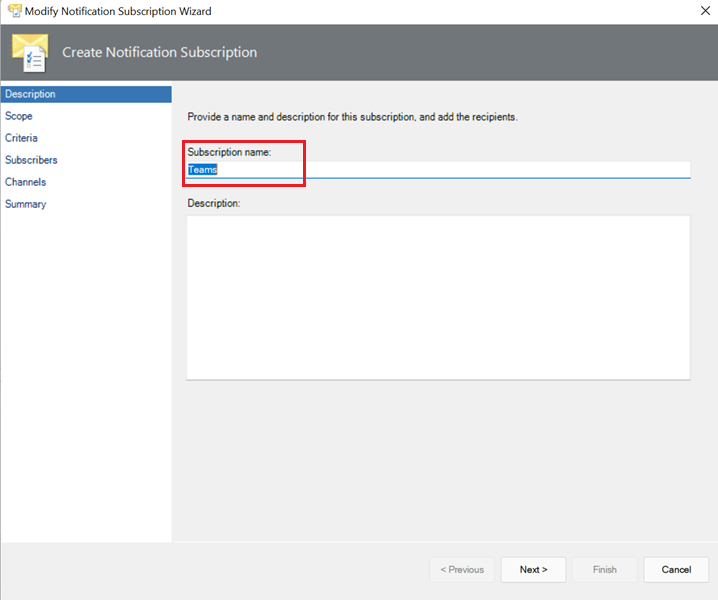
Set the Scope and Criteria to define the type of alerts you want notifications for.
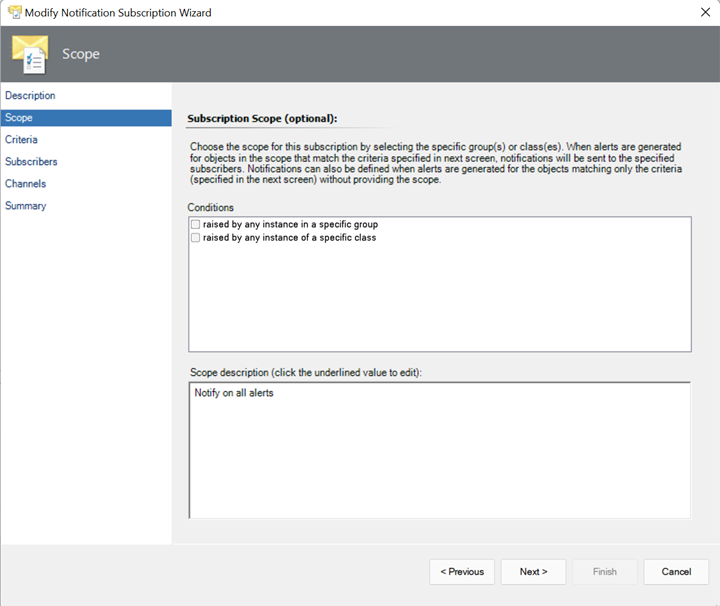

Under Subscribers, select Search, select the subscriber, and select Next.

Under Channels, select Search, select the desired notification channel, and select Next.

Under Summary, review the summary, and select Finish.
Next steps
To create an email notification channel, see How to enable an email notification channel.
To create a command channel notification, see How to enable a command notification channel.
To create a text message (SMS) notification channel, see How to enable a text message (SMS) notification channel.
Feedback
Coming soon: Throughout 2024 we will be phasing out GitHub Issues as the feedback mechanism for content and replacing it with a new feedback system. For more information see: https://aka.ms/ContentUserFeedback.
Submit and view feedback for